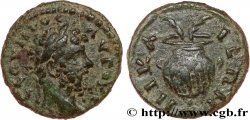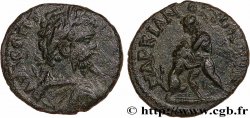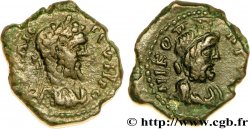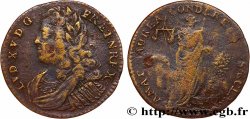v21_2713 - SEPTIMIUS SEVERUS Denier
MONNAIES 21 (2004)
Startpreis : 300.00 €
Schätzung : 550.00 €
unverkauftes Los
Startpreis : 300.00 €
Schätzung : 550.00 €
unverkauftes Los
Type : Denier
Datum: 193
Name der Münzstätte / Stadt : Roma
Metall : Silber
Der Feingehalt beträgt : 650 ‰
Durchmesser : 17,5 mm
Stempelstellung : 12 h.
Gewicht : 2,49 g.
Seltenheitsgrad : R1
Kommentare zum Erhaltungszustand:
Beau portrait. Flan large, mais sa cirdconférence touchant légèrement la légende. Joli revers. Jolie patine de médaillier avec des reflets dorés
N° im Nachschlagewerk :
Vorderseite
Titulatur der Vorderseite IMP CAE L SEP - SEV PERT AVG.
Beschreibung Vorderseite Tête laurée de Septime Sévère à droite (O*).
Übersetzung der Vorderseite "Imperator Cæsar Lucius Septimus Severus Pertinax Augustus", (L’empereur César Lucius Septime Sévère Pertinax Auguste).
Rückseite
Titulatur der Rückseite LEG XIIII GEM M V// TR P COS.
Beschreibung Rückseite Aigle légionnaire, avec un collier autour du cou, entre deux enseignes militaires.
Übersetzung der Rückseite "Legio quartum decimum Gemina Martia Victrix// Tribunicia Potestate Consul", (La quatorzième légion Gemina Martia Victrix// revêtu de la puissance tribunitienne consul).
Kommentare
Il revient à l’école anglaise et aux travaux de P. V. Hill, The Coinage of Septmius Severus and his family of the Mint of Rome A.D. 193-217, Londres 1977, d’avoir reclassé les différentes émissions de l’atelier de Rome, grâce à la théorie des cycles et d’avoir mis en lumière l’organisation de l’atelier de Rome qui travaille en officines et non pas en fonction du métal comme l’avaient décrit les numismates du XIXe siècle. Poids léger.
It is due to the English school and the work of PV Hill, The Coinage of Septmius Severus and his family of the Mint of Rome AD 193-217, London 1977, to have reclassified the different issues of the mint of Rome, thanks to the theory of cycles and to have highlighted the organization of the mint of Rome which works in workshops and not according to the metal as the numismatists of the 19th century had described it. Light weight
It is due to the English school and the work of PV Hill, The Coinage of Septmius Severus and his family of the Mint of Rome AD 193-217, London 1977, to have reclassified the different issues of the mint of Rome, thanks to the theory of cycles and to have highlighted the organization of the mint of Rome which works in workshops and not according to the metal as the numismatists of the 19th century had described it. Light weight








 Berichten über einen Fehler
Berichten über einen Fehler Die Seite drucken
Die Seite drucken Teilen meiner Auswahl
Teilen meiner Auswahl Stellen Sie eine Frage
Stellen Sie eine Frage Einlieferung/Verkauf
Einlieferung/Verkauf
 Details
Details















